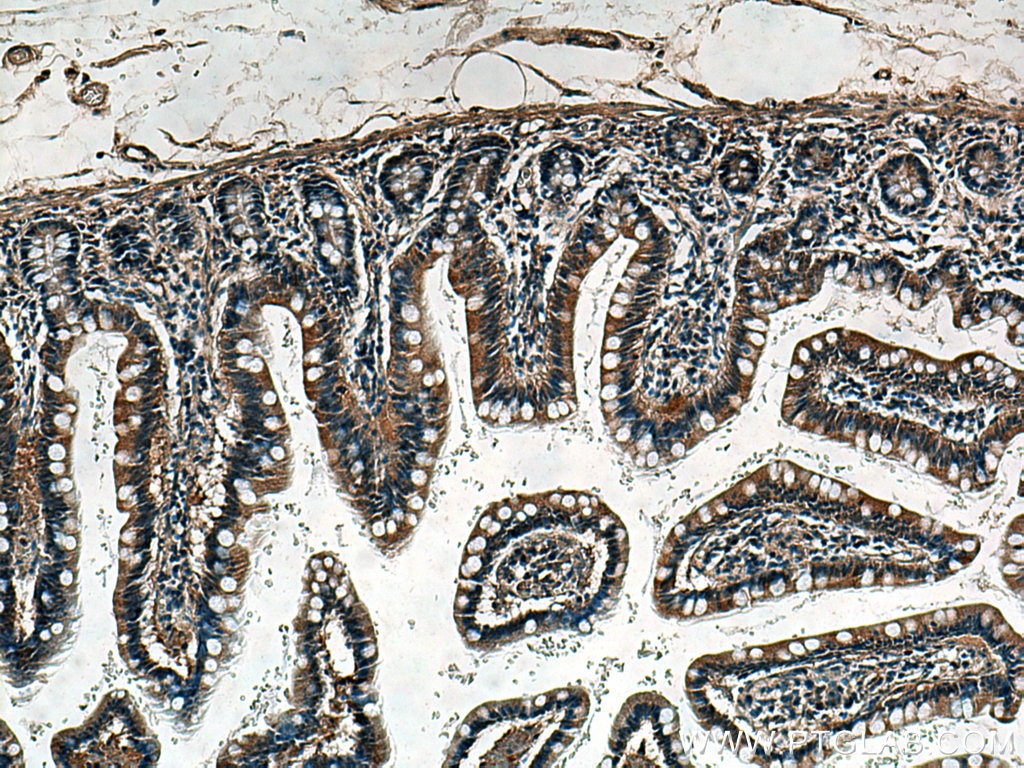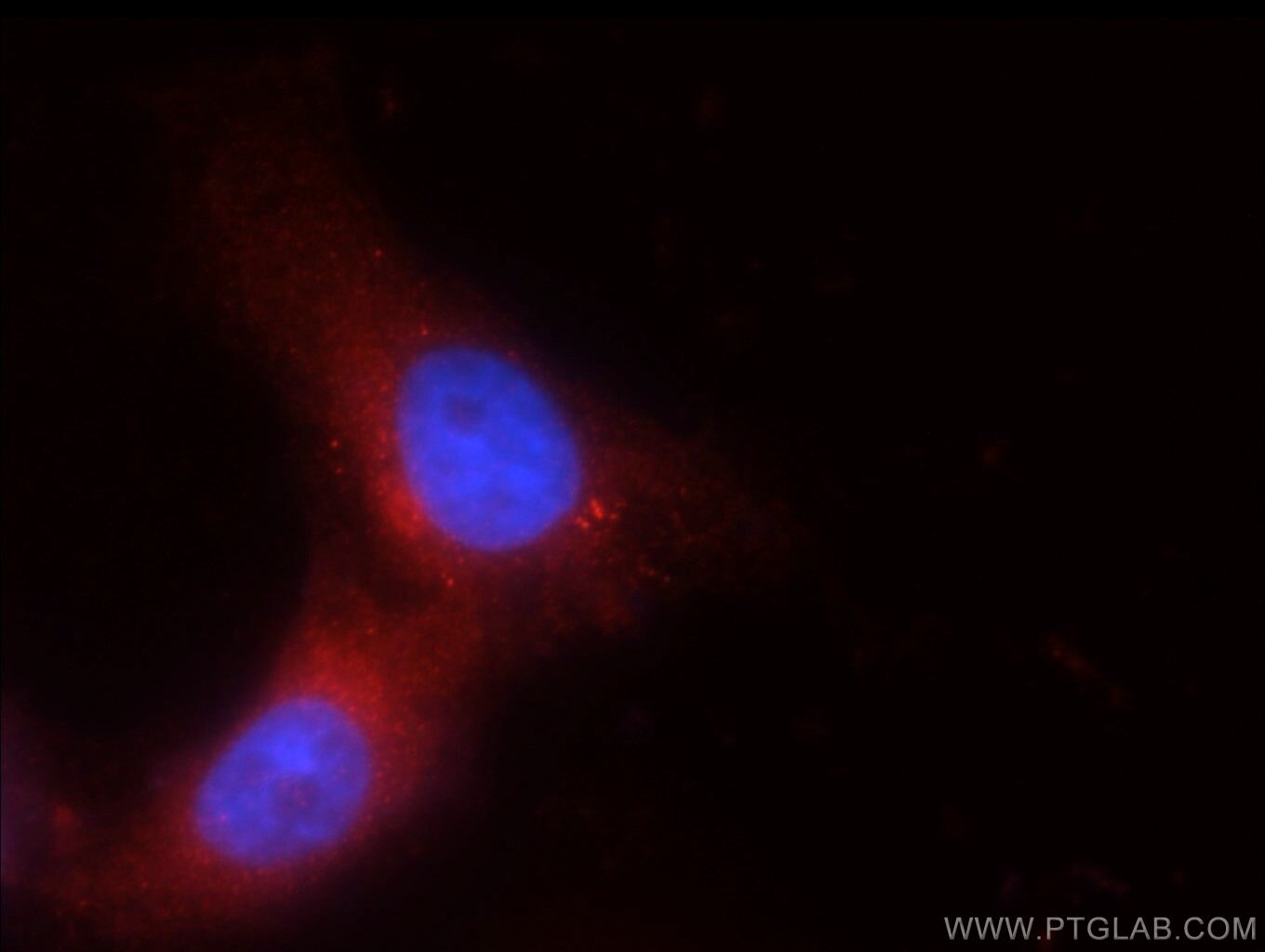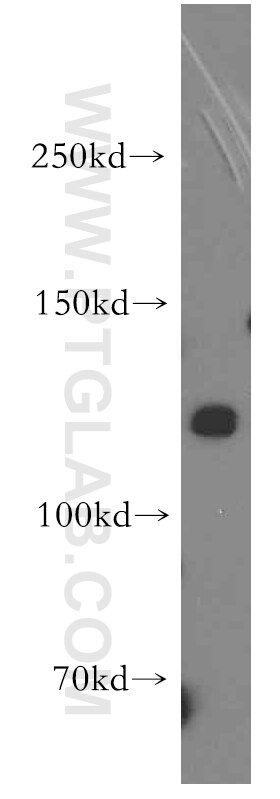- Phare
- Validé par KD/KO
Anticorps Polyclonal de lapin anti-TRPM5
TRPM5 Polyclonal Antibody for WB, IF, IHC, ELISA
Hôte / Isotype
Lapin / IgG
Réactivité testée
Humain, rat, souris
Applications
WB, IF, IHC, ELISA
Conjugaison
Non conjugué
N° de cat : 18027-1-AP
Synonymes
Galerie de données de validation
Applications testées
| Résultats positifs en WB | tissu hépatique de souris, |
| Résultats positifs en IHC | tissu d'intestin grêle humain, il est suggéré de démasquer l'antigène avec un tampon de TE buffer pH 9.0; (*) À défaut, 'le démasquage de l'antigène peut être 'effectué avec un tampon citrate pH 6,0. |
| Résultats positifs en IF | tissu d'épithélium olfactif de souris |
Dilution recommandée
| Application | Dilution |
|---|---|
| Western Blot (WB) | WB : 1:500-1:1000 |
| Immunohistochimie (IHC) | IHC : 1:50-1:500 |
| Immunofluorescence (IF) | IF : 1:50-1:200 |
| It is recommended that this reagent should be titrated in each testing system to obtain optimal results. | |
| Sample-dependent, check data in validation data gallery | |
Applications publiées
| KD/KO | See 1 publications below |
| WB | See 4 publications below |
| IF | See 3 publications below |
Informations sur le produit
18027-1-AP cible TRPM5 dans les applications de WB, IF, IHC, ELISA et montre une réactivité avec des échantillons Humain, rat, souris
| Réactivité | Humain, rat, souris |
| Réactivité citée | rat, Humain, souris |
| Hôte / Isotype | Lapin / IgG |
| Clonalité | Polyclonal |
| Type | Anticorps |
| Immunogène | TRPM5 Protéine recombinante Ag12593 |
| Nom complet | transient receptor potential cation channel, subfamily M, member 5 |
| Masse moléculaire calculée | 98 kDa, 131 kDa |
| Poids moléculaire observé | 98 kDa |
| Numéro d’acquisition GenBank | BC093787 |
| Symbole du gène | TRPM5 |
| Identification du gène (NCBI) | 29850 |
| Conjugaison | Non conjugué |
| Forme | Liquide |
| Méthode de purification | Purification par affinité contre l'antigène |
| Tampon de stockage | PBS avec azoture de sodium à 0,02 % et glycérol à 50 % pH 7,3 |
| Conditions de stockage | Stocker à -20°C. Stable pendant un an après l'expédition. L'aliquotage n'est pas nécessaire pour le stockage à -20oC Les 20ul contiennent 0,1% de BSA. |
Informations générales
Transient receptor potential (TRP) proteins are a diverse family of proteins with structural features typical of ion channels (PMID: 14634208). TRPM5 is a member of the TRPM (melastatin-like) subfamily which are Ca(2+)-permeable cation channels localized predominantly to the plasma membrane (PMID: 11864597). TRPM5 plays a central role in taste transduction (PMID: 17610722). TRPM5 is implicated in enhancing TRPA1 expression and may be involved in regulating insulin secretion (PMID: 21932052). Alternative splicing results in transcript variants encoding distinct isoforms with calculated molecular weights of 98 kDa or 131 kDa. It has been reported that TRPM5 is N-linked glycosylated at a unique site and TRPM5 glycosylation seems not to be involved in channel trafficking, but mainly in its functional regulation (PMID: 24605085).
Protocole
| Product Specific Protocols | |
|---|---|
| WB protocol for TRPM5 antibody 18027-1-AP | Download protocol |
| IHC protocol for TRPM5 antibody 18027-1-AP | Download protocol |
| Standard Protocols | |
|---|---|
| Click here to view our Standard Protocols |
Publications
| Species | Application | Title |
|---|---|---|
Immunity Intestinal Tuft-2 cells exert antimicrobial immunity via sensing bacterial metabolite N-undecanoylglycine. | ||
Food Funct Piperine, as a TAS2R14 agonist, stimulates the secretion of glucagon-like peptide-1 in the human enteroendocrine cell line Caco-2.
| ||
Appetite Chronic exposure to liquid sucrose and dry sucrose diet have differential effects on peripheral taste responses in female rats. | ||
Respir Res Human airway tuft cells influence the mucociliary clearance through cholinergic signalling | ||
Curr Med Sci Insufficient TRPM5 Mediates Lipotoxicity-induced Pancreatic β-cell Dysfunction |









